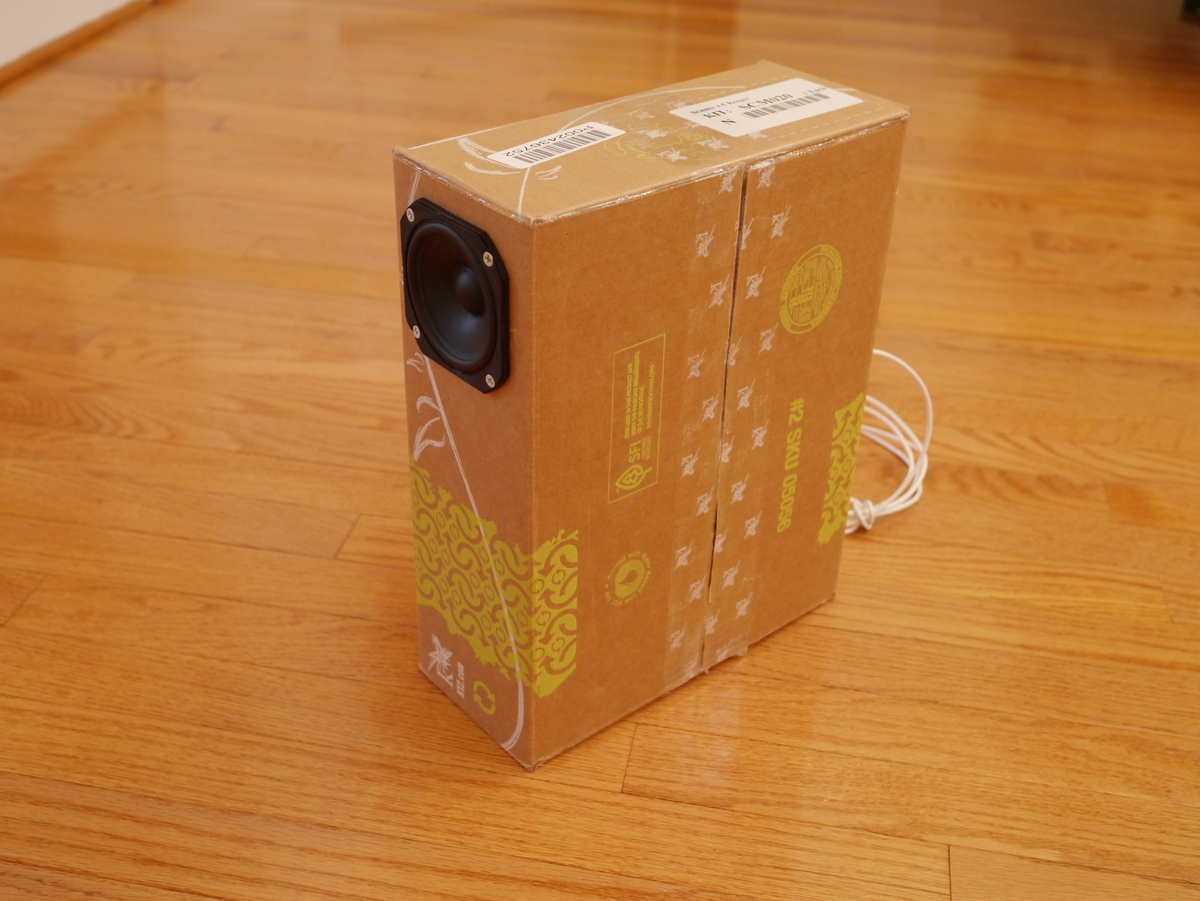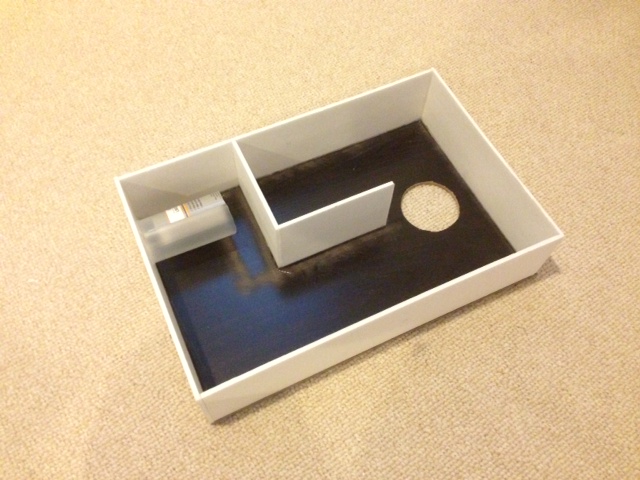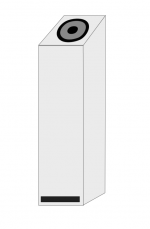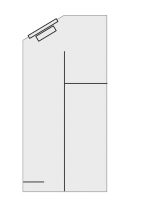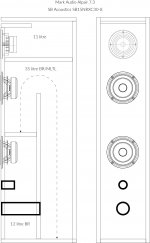I should have labelled those graphs a little better - if you hover over them you can see the filenames... All of the graphs are based on a 60L enclosure with a 25x270x325mm vent (1x10.5x12.8 inches) - based on my "test enclosure" (haven't finished building it yet) of 270x294x755 internal dimensions.
First graph is just the plain BR box (elongated - 794cm2 by 75.5cm long) with the driver placed at 37.7cm from the closed end - which has the first resonance at around 460Hz - move it and you get another resonance at around 230Hz.
Second graph is the same enclosure with a vertical divider - essentially halving the CSA to 397cm2 but doubling the length (for ease of simulation) - although I moved the speaker to the center location to dampen that first resonance again - just visible at around 120Hz.
Third graph is the same enclosure with the vertical divider but the speaker at the same location as the first graph - ie quarter of the enclosure, but same physical location on the box.
Fourth graph is the same as the first - ie elongated BR box, with 120g stuffing in the chamber (2kg/m3) and 60g in the vent (30kg/m3) - not sure how realistic the vent stuffing is, but it has a big effect - the denser, the better (to a certain extent, it turns it into a sealed enclosure eventually)
I was quite surprised at the first sim - I've tended to use the 0.33 position as a starting point. I wonder if it has to do with the lengths I've chosen (755mm height of box, 325mm long vent) and I suspect the type of stuffing likely makes a difference too - 2kg/m3 is not very dense, whereas 30kg/m3 is quite different. Also the sizing may impact things too - I may try golden ratios (0.618/1/1.618) but Leonard Audio doesn't really let you sim that - only cross sectional area and length...
In my actual speaker build I will likely line the internal walls with thick felt or wool carpet, and maybe some extra foam - but I'm not sure how to achieve 60g in the port yet. Location of the stuffing will likely have an effect too.
First graph is just the plain BR box (elongated - 794cm2 by 75.5cm long) with the driver placed at 37.7cm from the closed end - which has the first resonance at around 460Hz - move it and you get another resonance at around 230Hz.
Second graph is the same enclosure with a vertical divider - essentially halving the CSA to 397cm2 but doubling the length (for ease of simulation) - although I moved the speaker to the center location to dampen that first resonance again - just visible at around 120Hz.
Third graph is the same enclosure with the vertical divider but the speaker at the same location as the first graph - ie quarter of the enclosure, but same physical location on the box.
Fourth graph is the same as the first - ie elongated BR box, with 120g stuffing in the chamber (2kg/m3) and 60g in the vent (30kg/m3) - not sure how realistic the vent stuffing is, but it has a big effect - the denser, the better (to a certain extent, it turns it into a sealed enclosure eventually)
I was quite surprised at the first sim - I've tended to use the 0.33 position as a starting point. I wonder if it has to do with the lengths I've chosen (755mm height of box, 325mm long vent) and I suspect the type of stuffing likely makes a difference too - 2kg/m3 is not very dense, whereas 30kg/m3 is quite different. Also the sizing may impact things too - I may try golden ratios (0.618/1/1.618) but Leonard Audio doesn't really let you sim that - only cross sectional area and length...
In my actual speaker build I will likely line the internal walls with thick felt or wool carpet, and maybe some extra foam - but I'm not sure how to achieve 60g in the port yet. Location of the stuffing will likely have an effect too.
Also just noticed I kinda rephrased Jerms's post - also because I'm starting out using this thread's guidelines as a good starting point for my next project.
Hi, this topic makes me feel like a ringing air volume. For one thing i think, all infos about ported enclosures belong into "musical instruments" or "Public Adress", because performance of a ported enclosure becomes very bad very soon belo tuning frequency. Even if you do not care to hear lo contras and sub-contras, you still do not want them to overload the driver. For another thing
There is the 10:1 rule of thumb; for every cm of board thickness, 10cm width between ribs is allowed. This rule presumes quite strong, quite dense material such as solid, layers or chips wood boards. Corrugated aluminium as used for aeroplanes will also work. Even card- and foam-board might, if one obeys a 5:1 rule.
(CC is suited for curved horns, which are self-stabilizing, and because a horn is by definition working as horn only within the frequency range, in which its dimension is greater than wavelength. CC also works for sealed enclosures, if they and their sound baffles are big enuff and hosting lo-mass, hi-compliance drivers.)
i doubt, that those builds really work as ported enclosures as calculated presuming rigid walls. I tried corrugated cardboard in this context and found, that this material is by far not rigid enuff. AFAIK foam board is not much stiffer than Corrugated Cardboard.
There is the 10:1 rule of thumb; for every cm of board thickness, 10cm width between ribs is allowed. This rule presumes quite strong, quite dense material such as solid, layers or chips wood boards. Corrugated aluminium as used for aeroplanes will also work. Even card- and foam-board might, if one obeys a 5:1 rule.
(CC is suited for curved horns, which are self-stabilizing, and because a horn is by definition working as horn only within the frequency range, in which its dimension is greater than wavelength. CC also works for sealed enclosures, if they and their sound baffles are big enuff and hosting lo-mass, hi-compliance drivers.)
Those above examples are not the best sounding speakers I have made that's for sure. But not because of foam or cardboard - design was off. Speakers I design now when using foam core of well braced and damping panels added for large areas to prevent large vibrations, sound quite nice. There are a lot of happy mini Karlsonator builders who used foam core. Inbuilt a TABAQ with foam core in a tear drop shape and it absolutely works well. Great deep bass down to 50Hz from a 3.5in Peerless aliuninun cone similar to commercial TABAQ.
http://www.diyaudio.com/forums/full-range/88787-tabaq-tl-tang-band-119.html#post4556798
Also DCR works very well:
http://www.diyaudio.com/forums/full-range/252627-viva-la-vifa-curvy-cabinet-dcr-tc9fd.html
The PMC like TL two way sounds fantastic:
http://www.diyaudio.com/forums/multi-way/281778-low-cost-pmc-inspired-tl-monitor-dc130a-dc28f.html
http://www.diyaudio.com/forums/full-range/88787-tabaq-tl-tang-band-119.html#post4556798
Also DCR works very well:
http://www.diyaudio.com/forums/full-range/252627-viva-la-vifa-curvy-cabinet-dcr-tc9fd.html
The PMC like TL two way sounds fantastic:
http://www.diyaudio.com/forums/multi-way/281778-low-cost-pmc-inspired-tl-monitor-dc130a-dc28f.html
Last edited:
Hmm, show sims please as both driver and vent ideally needs to be in a pipe odd harmonic, which in a MLTL is shifted down a little, i.e. 1/5th = 0.2/0.21, 1/3rd = 0.33/0.349, 2/5ths = 0.4/0.42, the lowest the driver should be located, ergo smoothest overall at the expense of least TL damping on vent resonance; so for limited ['sub'] bandwidth [BW] use, placing the driver, vent at the opposite ends yields the max pipe gain, vent damping.
With good TL action, vent location isn't too critical, just keep them below 4/5ths = 0.8/0.84.
Note these points shift when inverse or positive tapered, with the latter being optimum at 0.5-0.56 depending on flare rate.
As a general rule for [ML]TL alignments, only the inverse tapered will need any stuffing since the others are relying on 1/4 WL TL action to damp the vent, which becomes obvious when a reflex alignment's vent length needs to be shortened for the same tuning [audibly or at least obviously improved impulse response plot].
GM
Edit in red
I see most MLTL put the driver a bit lower than the top of the line.
How would I approach this if I wanted to make MLTL but with the driver on a slanted top?
Looking to do a surround / ambient / atmos style speaker but with the personality of the TABAQ.
Something like this, which is easily concealed around a room, using wall / ceiling reflections, instead of speakers hanging from the ceiling.
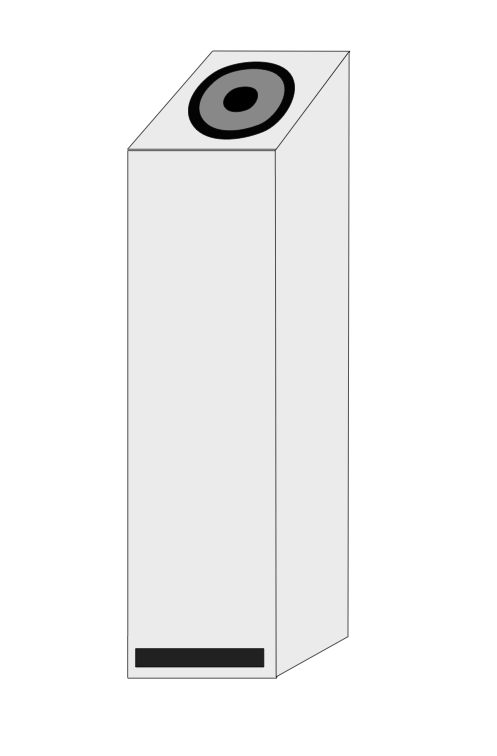
How would I approach this if I wanted to make MLTL but with the driver on a slanted top?
Looking to do a surround / ambient / atmos style speaker but with the personality of the TABAQ.
Something like this, which is easily concealed around a room, using wall / ceiling reflections, instead of speakers hanging from the ceiling.

Attachments
I see most MLTL put the driver a bit lower than the top of the line.
How would I approach this if I wanted to make MLTL but with the driver on a slanted top?
Looking to do a surround / ambient / atmos style speaker but with the personality of the TABAQ.
Something like this, which is easily concealed around a room, using wall / ceiling reflections, instead of speakers hanging from the ceiling.

If you fold it and make it "dumpy" or fat, it's not a problem. Just fold the line around the middle divider. Then figure out if slot port is possible or if it needs plastic pipe.
That's not quite the elegant tower though. as it's about 400x200x150mm.
Something similar to Cyburg's Needle might work.
If you fold it and make it "dumpy" or fat, it's not a problem. Just fold the line around the middle divider. Then figure out if slot port is possible or if it needs plastic pipe.
That's not quite the elegant tower though. as it's about 400x200x150mm.
Something similar to Cyburg's Needle might work.
A Cyburg's Needle with the driver on an angled top? That might work.
A Cyburg's Needle with the driver on an angled top? That might work.
That's what I was thinking. I also looked at maybe a "snake digesting a good meal" TL or MLTL with 64cm2 in front and behind a speaker chamber.
Either option seems to need a lot of stuffing.
Placement of driver at 1/3 from closed end reduces the first reflection from the exit (impedance mismatch) cancellation dip. It will work fine at the end - just might not be as smooth.
Thanks X,
That's what I was hoping to read. Since this is for ambient / surround duty, not having a ruler flat response will not be so critical.
I'll make one at first, just to see how it goes.
Should I stay with the TABAQ dimensions and just put the driver was on top, or should it be shorter?
That's what I was hoping to read. Since this is for ambient / surround duty, not having a ruler flat response will not be so critical.
I'll make one at first, just to see how it goes.
Should I stay with the TABAQ dimensions and just put the driver was on top, or should it be shorter?
How would I approach this if I wanted to make MLTL but with the driver on a slanted top?
Looking to do a surround / ambient / atmos style speaker but with the personality of the TABAQ.
End loaded require more stuffing for a given amount of 'ripple' Vs an offset driver, so odds are you might not be able to match the TABAQ's 'personality'.
The closest would be to fold the TABAQ to get the desired driver offset, slope angle.
GM
End loaded require more stuffing for a given amount of 'ripple' Vs an offset driver, so odds are you might not be able to match the TABAQ's 'personality'.
The closest would be to fold the TABAQ to get the desired driver offset, slope angle.
GM
Thanks GM,
So, maybe something like this?
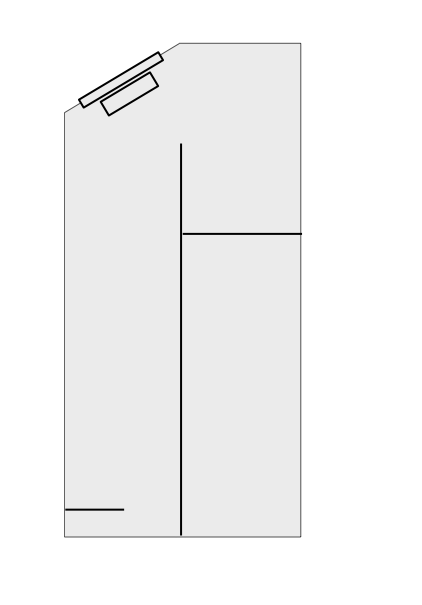
Attachments
Right, though probably better overall to just make the empty space a leg frame unless you want to make them separate 'filler' subs or storage bins for stuff that doesn't rattle.
GM
GM
This idea has really got me and I'm learning (I think) every day. From looking at some established designs it seems to me that when viewed without the MLTL effect the general idea is for a br box substantially larger than the recommended, and tuned below the resonant frequency of the drier, and one is then aiming to get the MLTL effect to help straighten things out - would that be correct?
I looked for example at the MLTL38 design for the Jordan Eikona 2, which supposedly goes down to 27Hz - when I put the numbers into a vented box calculator the optimum box is around 7 litres, but the MLTL38 is around 32 litres. Purely as a BR the predicted response at that volume slopes down by about 4db to the (much lower) cut off. Is that the kind of slope one ought to look for in doing regular BR modelling, with the hope that once the MLTL effects come into play the slope gets lifted back up?
I looked for example at the MLTL38 design for the Jordan Eikona 2, which supposedly goes down to 27Hz - when I put the numbers into a vented box calculator the optimum box is around 7 litres, but the MLTL38 is around 32 litres. Purely as a BR the predicted response at that volume slopes down by about 4db to the (much lower) cut off. Is that the kind of slope one ought to look for in doing regular BR modelling, with the hope that once the MLTL effects come into play the slope gets lifted back up?
The Eikona 2 has a lowish Qts, and this does not work as well in an accidental MLTL assumption. It has a Vas rated at 11liters. I would say 38liters for a MLTL is very oversized in order to get 27Hz tuning. IMO, that's too low and efficiency will suffer plus it may sound boomy. I would go no larger tha 2x the Vas normally or 22liter box.
The Eikona 2 would actually be a good candidate for an XKi, and there, you can make it same as Vas and it will reach fs of 47Hz (-3dB) in a 11liter box.
The Eikona 2 would actually be a good candidate for an XKi, and there, you can make it same as Vas and it will reach fs of 47Hz (-3dB) in a 11liter box.
That's great. I'm not actually panning one doing anything with the Eikona - it just happened to be a published design I had seen which I compared to what a normal br tuning looked like, just to try and learn intuitively what to aim for.
The driver I do have in mind is a 5" with a total Q of .33 and a VAS of 20.7 litres. With my design I have a volume of about 35 litres, so by your rule of thumb that's in the right area?
Another thing that is interesting is knowing how big to make the port. I can do a regular br sim with an online calculator and see what the response looks like with the dimensions I have in mind, but from reading here it by no means certain that the same port will be best for MLTL.
The driver I do have in mind is a 5" with a total Q of .33 and a VAS of 20.7 litres. With my design I have a volume of about 35 litres, so by your rule of thumb that's in the right area?
Another thing that is interesting is knowing how big to make the port. I can do a regular br sim with an online calculator and see what the response looks like with the dimensions I have in mind, but from reading here it by no means certain that the same port will be best for MLTL.
I must add a huge thank you for the sharing of this, which has been giving me tons to think about for quite some while, and hopefully will yield some nice new speakers for me when I can put all my ideas together.
What I have in mind is two 5" drivers just for bass (crossover no higher than 400) in separate parts of a floorstander. One with a conventional tune, either br or even sealed, and one in a MLTL for maximum extension (plus a full range in the top part of the cabinet). By using an active crossover and two inexpensive stereo amps for bass I hope to end up with an arrangement that can be fine-tuned for bass - maximum extension when wanted, a tighter sound sometimes etc. I hope it will be possible to match the speaker to room gain, plus have on-hand some rumble for HT or a gentler sound for late at night.
What I have in mind is two 5" drivers just for bass (crossover no higher than 400) in separate parts of a floorstander. One with a conventional tune, either br or even sealed, and one in a MLTL for maximum extension (plus a full range in the top part of the cabinet). By using an active crossover and two inexpensive stereo amps for bass I hope to end up with an arrangement that can be fine-tuned for bass - maximum extension when wanted, a tighter sound sometimes etc. I hope it will be possible to match the speaker to room gain, plus have on-hand some rumble for HT or a gentler sound for late at night.
Attachments
Why would the full range need to be ported on top if crossing around 400Hz?
Partly because there is no reason for it not to be.
I haven't finished that part of the design, but what I want is some sort of labyrinth or aperiodic arrangement that removes the rear waves to as full an extent as possible without actual tuning. I have ideas, still brewing!
Oh, and also the top enclosure if big enough to change the full range at a later date.
- Home
- Loudspeakers
- Full Range
- Accidental MLTL Technique
